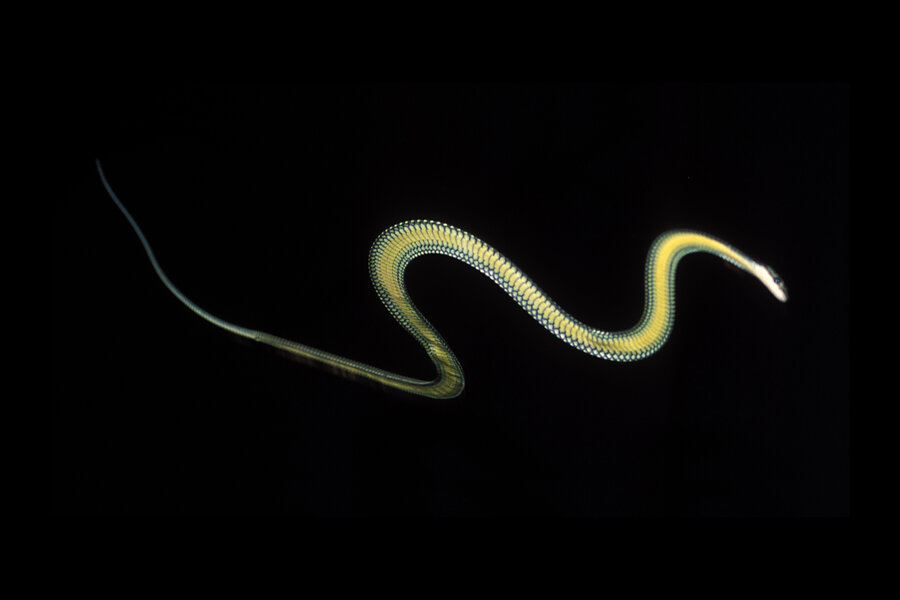Snakes on a higher plane: reptilian flight secrets revealed
Loading...
Once upon a time in prehistory, some gifted contortionist of a snake sucked in its tummy, spread its ribs, and soared to reproductive success.
The nimblest of that creature's five descendant species now flies through the forests of southeast Asia, and is known to humans as Chrysopelea paradisi, or the Paradise Flying Snake. But unlike most of the animal kingdom's fliers – such as birds, bats, and flying squirrels – these reptiles neither flap nor coast. Nothing on their body resembles a wing.
Instead, the typically tubular animals press their midsections into a roughly triangular shape as they fling themselves into the air, propelling themselves forward with fishy, side-to-side undulations. According to National Geographic, they can travel up to 300 feet through the air this way. So how do they do it?
The unusual shape they assume turns out to have strange aerodynamic properties, a team of biomechanists has found.
Like flying snakes, airplanes also stay aloft with the help of triangle-like shapes; air travels more quickly across an airplane wing's diagonal top than it does across its flat bottom, weakening the relative air pressure on top, and creating the wonder of lift. But those wings are thin, long, and relatively light; there's no thin part on a snake.
Paradise Flying Snakes, while launching themselves from a tree, rearrange their ribs to create a flat, somewhat concave surface along their bellies, with the rest of their bodies creating the rounded top of a triangle, in cross section.
To understand what this shape does for them, Researchers at Virginia Tech University isolated it from the snake's other dimensions and its undulating motion, by 3D printing a stiff, uniform rod with the same cross-sectional shape.
Studying the behavior of this shape in a water tunnel, they found that it is uniquely good at gathering lift, even when its flight begins with a near-vertical plummeting motion. This is significant for snakes, because their best efforts to fling themselves away from trees aren't particularly strong.
Jake Socha, a co-author of the study who has been studying Paradise Flying Snakes for over a decade, says they commonly embark at a precipitous 60 degree angle to the ground. But, he says, by the time they land (usually on another tree), they have gathered enough lift to move almost horizontally – he has seen them land while moving at an angle as flat as 13 degrees to the ground.
Why do these snakes bother flying when the rest of the world's serpents are content to slither? Scientists haven't yet answered that.
"They are not gliding through the air to hunt," says Dr. Socha. "Their prey items tend to glide better than they do, anyway. We don't know why they use it in the wild, to tell you the truth, but it's probably for escape from predators, or for fast, effective travel between trees."
Meanwhile, the growing understanding of their aerodynamics may have biomimetic applications in the human world.
"One is micro-air vehicles – vehicles that travel through the air that are small, like insects," says Socha. "The other cool thing might be, if you were to make a snake robot that could crawl and climb and slither, and get through rubble, and also soar." Could future disaster relief efforts enlist robo-serpents? "That's what I'd like to see," says Socha.








